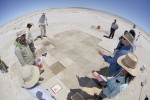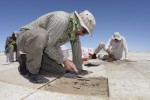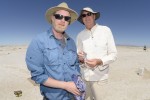 Archaeologists excavating the Utah Test and Training Range inside the Hill Air Force Base have discovered a 12,300-year-old hearth that sheds new light on the earliest inhabitants of Utah. The 2,675-square-mile training range is in the arid West Desert of Utah, which is why it was selected for training exercises and bomb testing, but it was once a lush wetland, a network of rivers, lakes and marshes that was home to a great variety of flora and fauna.
Archaeologists excavating the Utah Test and Training Range inside the Hill Air Force Base have discovered a 12,300-year-old hearth that sheds new light on the earliest inhabitants of Utah. The 2,675-square-mile training range is in the arid West Desert of Utah, which is why it was selected for training exercises and bomb testing, but it was once a lush wetland, a network of rivers, lakes and marshes that was home to a great variety of flora and fauna.
The West Desert is a potentially inestimable source of archaeological information because it was thriving wetland from the release of Lake Bonneville about 14,500 years ago until about 8,500 years ago. That window of 8,000 years is the only time before the modern era when people lived in the oasis while the area around it began to dry up. It also has geologic features that give archaeologists the rare opportunity to date artifacts found there. Black mats, for instance, decayed plant material in ancient marshland that are now layers of black soil, can be radiocarbon dated. They also preserve plants, fish, shells and other organic remains which open a window into the prehistoric environment.
 The Air Force has worked with the Utah State Historic Preservation Office for years to identify and preserve archaeological materials on the range. Because it’s such a large area in which cultural treasures could easily be lost or destroyed by military activities, archaeologists don’t wait to hear about random discoveries. They survey areas with the highest likelihood of archaeological remains as calculated by a probability model based on previous finds, comparable environments and existing research. Between four and eight square miles of the range are surveyed every year.
The Air Force has worked with the Utah State Historic Preservation Office for years to identify and preserve archaeological materials on the range. Because it’s such a large area in which cultural treasures could easily be lost or destroyed by military activities, archaeologists don’t wait to hear about random discoveries. They survey areas with the highest likelihood of archaeological remains as calculated by a probability model based on previous finds, comparable environments and existing research. Between four and eight square miles of the range are surveyed every year.
Last year, the archaeological team surveyed several thousand acres pinpointed for exploration. The hearth was identified in one of those digs. Other artifacts were discovered elsewhere in the surveyed area, but the hearth overshadows them all in its significance. This year excavators returned to the hearth site. They recovered more than 60 objects, including tools, charcoal, duck and goose bones, tobacco seeds and lithics from tool manufacture. It’s a uniquely rich find.
The significance of the find helped the archaeologists determine that people occupied the region many thousands of years ago.
“Then there are questions about the significance of these people,” [Far Western senior archaeologist and lead for the current project Daron] Duke said. “They really are the first occupants of the Great Basin that we can demonstrate. If we went from the earliest accepted date of man in the Americas, approximately 13,400 years ago, people seemed to have dispersed all across the continent within a short, 500-year timespan.”
According to Duke, the first few people inhabiting this area moved around a lot.
“We do know that by the time of 13,000 years ago, 400 years after people are in North America, we get evidence of people in this area and the Great Basin,” he said. “The people then seemed to be pretty transitory. They might have seen megafauna (large animals) and possibly were hunting mammoths and giant forms of bison.”
The tobacco seeds are extraordinary as well. They are by thousands of years the earliest evidence of tobacco use. The next time tobacco appears on the archaeological record is about 3,000 years ago, a gap of more than 9,000 years.
 After the initial finds, the team dug a larger trench around the fire pit and found refuse all around it, from people tossing away the trash while seated around the fire. They also found a spear point.
After the initial finds, the team dug a larger trench around the fire pit and found refuse all around it, from people tossing away the trash while seated around the fire. They also found a spear point.
“Here in this location, we see possibly a more generalized diet of several species of ducks, which is not surprising [for people] working and living in a wetland,” [D. Craig Young, Far Western senior geoarchaeologist,] said. “Also of significance is that these people were carrying their big game tool kits, as evidenced by the big point found right next to the hearth. It’s about 8 to 10 centimeters long and one wouldn’t think that was being used to capture ducks. It could have been used to process the water fowl, but those large points tend to be associated with hunting of large game.”
The objects discovered at the fire pit will be conserved and possibly displayed at the Natural History Museum of Utah in Salt Lake City.